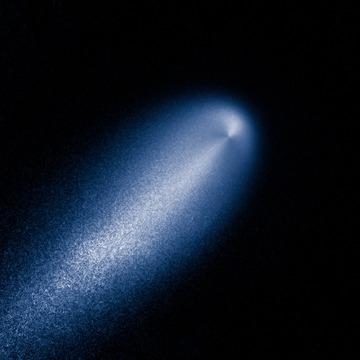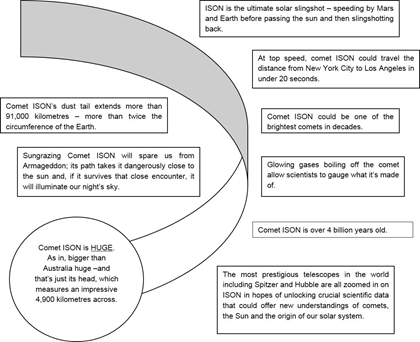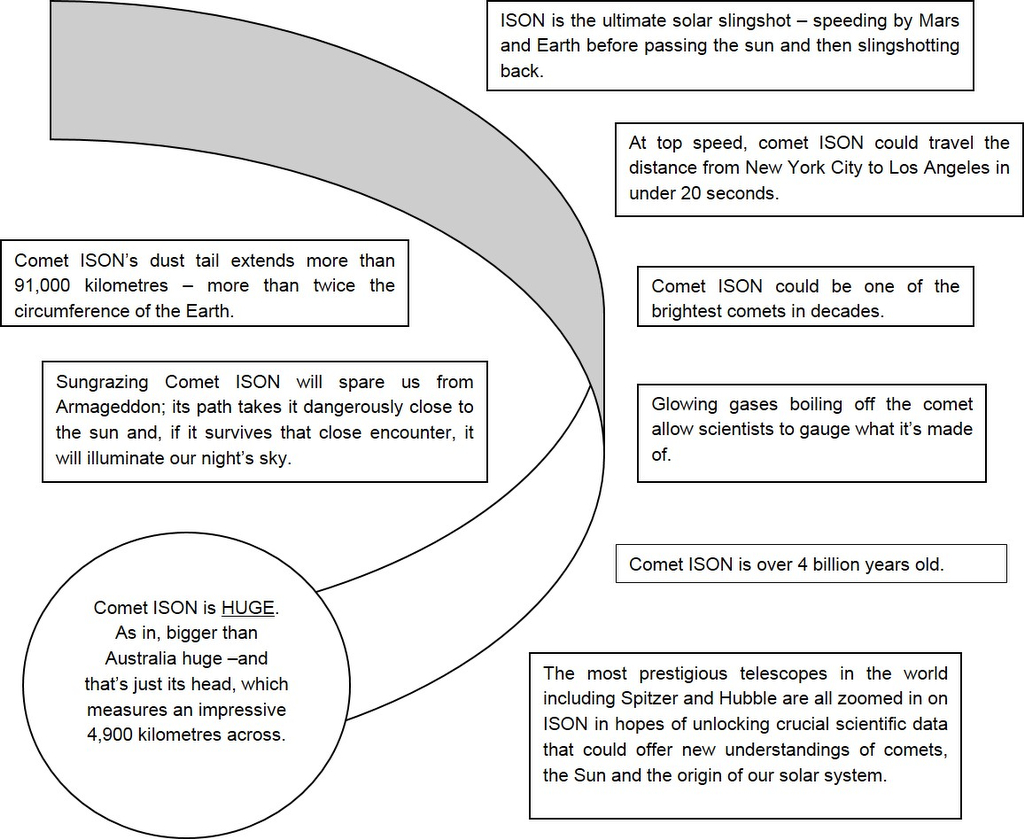NATIONAL GEOGRAPHIC CHANNELS INTERNATIONAL OFFERS VIEWERS
A ONCE-IN-A-LIFETIME LOOK AT ISON, THE COMET OF THE CENTURY,
IN NEW PRODUCTION FROM DARLOW SMITHSON
(Asia – November 21, 2013) National Geographic Channels International has announced the co-production of Comet of the Century from Darlow Smithson Productions. A year in the making, the special tracks what promises to be one of the most stunning comets in modern times, as comet ISON prepares its death-defying trek around the sun. Comet of the Century will premiere later this month in 170 countries.
Premiering across Hong Kong and Southeast Asia this Sunday November 24th at 10PM HKT/SIN on the National Geographic Channel (SingTel mio TV Ch. 201, StarHub TV Ch. 411), Comet of the Century offers viewers a front row seat to this once-in-a-lifetime event. With breath-taking images captured using cutting edge technology, audiences come as close to our new comet as the world’s most complex and high-tech telescopes can bring them. Following world-class scientists who are tracking ISON’s every move to glean key insight into this comet, the special illuminates the cosmic secrets hidden on and beneath ISON’s surface. Along the way, it also highlights ISON’s origins, what will happen on its trajectory around the sun and planet Earth, and mankind’s fiery relationship with epic comet phenomena.
“Comet of the Century brilliantly illuminates comet ISON – a rare, spectacular wonder, which can capture the imagination of viewers around the world,” said Hamish Mykura, Executive Vice President and Head of International Content for NGCI.
“Comet of the Century takes us on a rollercoaster ride into some mind-boggling science in a way that will be thoroughly entertaining to a global audience. We are thrilled to be working with NGCI and PBS on this spectacular project,” said Iain Riddick, Head of Special Projects and Digital Media for Darlow Smithson.
For fast facts on the science and makeup of Comet ISON, please see appendix.
###
APPENDIX
Comet ISON is About to Make its Intergalactic Earthly Debut
National Geographic Channel Shares What to Know About the “Dirty Snowball” of the Cosmos
Reaching speeds as high as 684,000 kilometres per hour, Comet ISON has been billed by world-class astronomers as the COMET OF THE CENTURY. But, for those of us who can’t tell cosmic cool from meteoric mediocrity, here’s a crash course in comets, just how amazing ISON is and why we won’t be needing Bruce Willis for planetary protection.
So, grab a front row seat to a once-in-a-lifetime event on Sunday November 24th at 10PM HKT/SIN when National Geographic Channel across Hong Kong & Southeast Asia introduces COMET OF THE CENTURY. With breath-taking images captured using cutting edge technology, audiences come as close to our new comet as telescopes allow them – and now with a little bit of instruction, we can call ourselves transitional astronomers.
COMET ISON: FAST FACTS
COMETS: A CRASH COURSE
WEIRD WORLDS
Comets, affectionately known as the “dirty snowballs” of the cosmos, are described as weird, low-gravity worlds of ice, rock and gas composed from the debris of millions of years ago. Tiny dust particles and ice crystals merge together slowly over tens of millions of years until they form large, city-sized chunks like ISON. A cloud of gas and dust – the coma – surrounds a hard nucleus that is typically less than 10 kilometers in diameter. These icy interlopers can reach astronomical sizes as they sizzle through interstellar space. The amorphous tails of comets are bright because their dust reflects sunlight.
HEAVENLY HARBINGERS
Although much of the world will watch in awe as comet ISON sweeps across the night sky, humans have long had a love-hate relationship with these cosmic creations. For centuries, comets were considered a bad omen. Even to this day there are cultures that believe comets bring plagues and wars. From the Romans, Incas, and ancient Mongols through the Middle Ages and even in the modern world, comets were seen as harbingers of doom sent by the gods to warn humans of their wrath. But, some scientists believe that comets may have brought much of the Earth’s water to our planet 3.8 billion years ago – enabling life to flourish for billions of years.
SECRETS OF THE SOLAR SYSTEM
Comets can give scientists a glimpse into the past of our solar system, a view of the earliest moments of our world’s existence. Scientists want to explore the possibility that billions of years ago, comets brought water to the new-born Earth and if ISON holds any organic molecules – the building blocks of our existence. The insurmountable possible answers that ISON may offer are staggering.
Similar Threads:




 LinkBack URL
LinkBack URL About LinkBacks
About LinkBacks










 Reply With Quote
Reply With Quote

Bookmarks